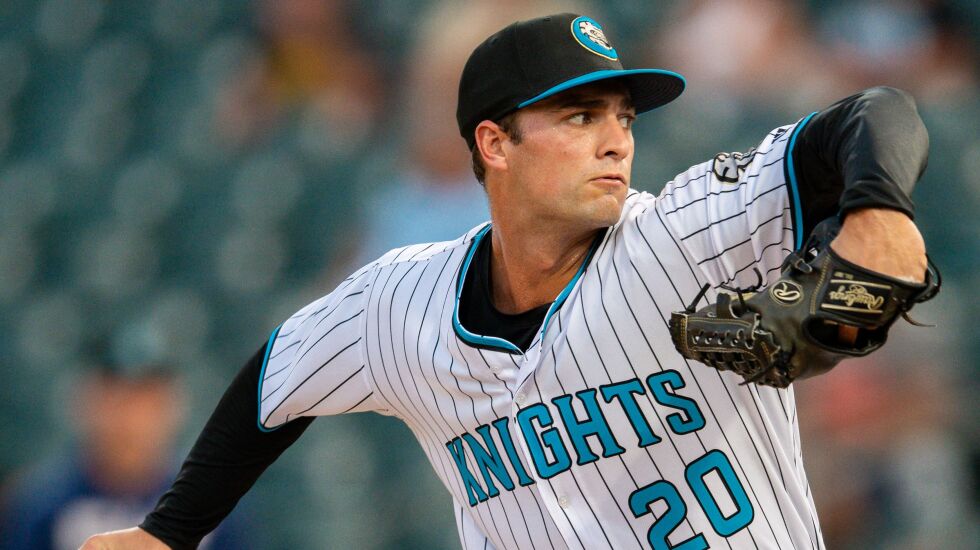
In 2021, his last year at UCLA, newly acquired White Sox prospect Nick Nastrini lost the strike zone and his confidence, and he slid to the fourth round of the draft.
Two years later, speaking on a Zoom call in Birmingham with a Dodgers duffel bag stuffed in his car back seat, you wouldn’t know it.
“If I’m executing that day, good luck,” Nastrini said at the end of an explanation of how he feels his changeup fading to his arm side rounds out an arsenal powered by his four-seamer and two breaking balls.
But the 23-year-old right-hander’s confidence extends beyond pitch-mix discussions. He’s grateful for the vaunted Dodgers player-development engine that jump-started his pro career but also appreciates his new surroundings after being traded as part of a deal for Lance Lynn and Joe Kelly. He doesn’t hesitate to note the clearer path to the majors with the woebegone Sox.
“He’s a very confident human,” Double-A Birmingham pitching coach Danny Farquhar said. “He plans his outings before he meets with me and the catcher. He has a plan; he has a reason for everything he wants to do.”
“Having gone through that and come out the other side,” Nastrini said of working through the yips as a college junior, “I’ve acquired these mental tools that help me get from bad pitch to bad pitch, bad inning to bad inning, get from a bad game to a good game and turn it around quickly.”
Nastrini said “the whole cause of the yips was a mechanical thing turned into a mental thing.” Scouts praise Nastrini for his athleticism, which typically bodes well for a pitcher repeating his delivery.
Despite that, Nastrini has an 11.3% walk rate for his professional career. Even after pitching well enough upon arrival to the Sox’ organization to earn a promotion to Triple-A Charlotte, strike-throwing is the issue that can hold Nastrini back from his mid-rotation potential.
“It’s really just understanding how my stuff plays,” Nastrini said. “When to use my stuff, pitch selection. That’s kind of where my development has been this past season. It’s understanding what pitches I can throw in what counts, what I can use to get early strikes, what I can use to put guys away with.”
An early example of this would be Nastrini’s changeup. While it’s his fourth pitch and often something pitchers set up to use as a put-away, the swing-and-miss rate on it when Nastrini is able to locate it in the zone is such that Farquhar encouraged using it earlier in the count to get ahead.
Five years ago, Farquhar was a veteran reliever in the Sox’ clubhouse, unafraid to draw from his experience digesting pitch data reports from the Rays to assert that a young Lucas Giolito should throw his four-seamer at the top of the zone more. Now Giolito and the promise of the Sox’ rebuild is gone, and Farquhar was coaching at Birmingham when pitching prospects Nastrini, Jake Eder, Ky Bush and catcher Edgar Quero were all dumped on his plate after the trade deadline.
And again, Farquhar thinks Nastrini should work at the top of the zone. It goes against what Nastrini was taught in college.
But with pitch data indicating his four-seam fastball can generate 20 inches of inverted vertical break, which is considered elite riding action, Farquhar sees everything opening up for Nastrini when he lives upstairs.
“There’s just so many whiffs when he would attack [opposing hitters] glove side at the top for the righties,” Farquhar said. “For the lefties, when he would stay away at the top of the zone, the fastball performance was through the roof.”
Often, walks can be about lacking the means to end at-bats sooner. Nastrini is threatening the 30% strikeout barrier that has been familiar to him since his breakout, but Farquhar looked at his touted slider and saw potential for more whiffs.
Having already changed his slider grip earlier in the season, Nastrini spent his early days in the Sox’ organization doing “short box” drills. Here, the catcher sets up in front of the plate, and shaping the slider for the shorter path trains the right-hander to add more depth to the pitch.
This is the work of a telling project for the Sox under new general manager Chris Getz. The minor-league system he has been overseeing is tasked with continuing the progress of the Dodgers’ best development system in the sport, where successful harnessing of powerful but erratic arms happens regularly.
For Nastrini, it’s nothing more daunting than what he has faced before.
“There’s a core group of young players in the minor-league system that can progress through together and get to the Show together, help bring a World Series to the White Sox,” Nastrini said. “That’s what we all want to do.”







